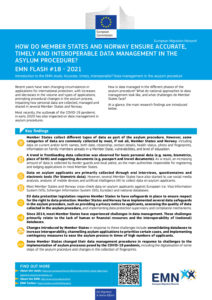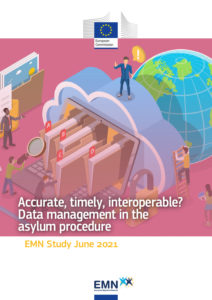What kind of data is collected by EU Member States and Norway and how is the data managed in the different phases of the asylum procedure? This new EMN Study provides comparable information and examples from 25 countries on different aspects of data management, including data cross-checking against national and international databases, data quality accuracy, and data protection issues. It also maps challenges encountered, and actions taken to respond to them. The study contributes to capacity-building of experts working in the field of asylum and generates a better understanding of the policies and process in place across Europe.
The new EMN study entitled “Accurate, timely, interoperable? Data management in the asylum procedure” examines how data are managed in the different phases of the asylum procedure (making, registering, lodging and examining) across the Member States and Norway and reflects the situation and developments between 2014 and 2020 in 24 EU Member States and Norway.
The findings indicate that data commonly collected during the asylum procedure consists of information on asylum applicants’ names, birth date, citizenship, contact details, health status, photo and fingerprints, information on family members already in a Member State, vulnerabilities, and level of education. Such data are primarily collected through oral interviews, questionnaires and electronic tools for biometric data. Several Member States have also started to use social media analysis, analysis of mobile devices and artificial intelligence (AI) in the data collection process.
In terms of data quality assessment and data protection, the study found that most Member States and Norway cross-check data collected during the asylum procedure against European and national databases. Only a minority cross-check information against international databases. Member States and Norway have also implemented several data safeguards in the asylum procedure, such as providing a privacy notice to applicants, assessing the quality of data collected, and implementing data protection supervisory and compliance mechanisms.
The most common challenges experienced by the Member States and Norway relate to human or financial resource constraints and the interoperability of databases. Changes introduced by Member States in response to challenges include consolidating databases to increase interoperability, channelling asylum applications to prioritise certain cases, and implementing contingency measures to ease the asylum process in times of high numbers of applicants. Data is also increasingly collected in the early stages of the procedure. This so-called frontloading practice allows authorities to access applicants’ information in the early phase, to prioritise certain categories of applications, to save on administrative capacity overall and facilitate access to data.
In addition, in response to recent challenges posed by the COVID-19 pandemic, some Member States have (further) digitalised steps of the asylum procedure and introduced changes in the collection of fingerprints.

